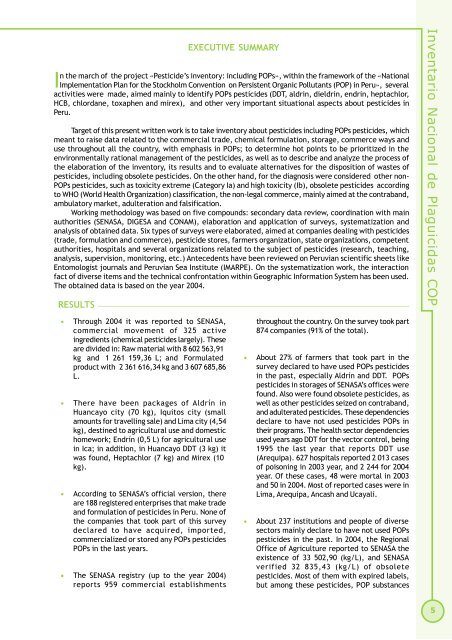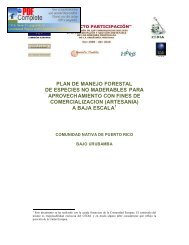Inventario Nacional de Plaguicidas - Ministerio del Ambiente
Inventario Nacional de Plaguicidas - Ministerio del Ambiente
Inventario Nacional de Plaguicidas - Ministerio del Ambiente
Create successful ePaper yourself
Turn your PDF publications into a flip-book with our unique Google optimized e-Paper software.
EXECUTIVE SUMMARY<br />
In the march of the project «Pestici<strong>de</strong>’s inventory: including POPs», within the framework of the «National<br />
Implementation Plan for the Stockholm Convention on Persistent Organic Pollutants (POP) in Peru», several<br />
activities were ma<strong>de</strong>, aimed mainly to i<strong>de</strong>ntify POPs pestici<strong>de</strong>s (DDT, aldrin, dieldrin, endrin, heptachlor,<br />
HCB, chlordane, toxaphen and mirex), and other very important situational aspects about pestici<strong>de</strong>s in<br />
Peru.<br />
Target of this present written work is to take inventory about pestici<strong>de</strong>s including POPs pestici<strong>de</strong>s, which<br />
meant to raise data related to the commercial tra<strong>de</strong>, chemical formulation, storage, commerce ways and<br />
use throughout all the country, with emphasis in POPs; to <strong>de</strong>termine hot points to be prioritized in the<br />
environmentally rational management of the pestici<strong>de</strong>s, as well as to <strong>de</strong>scribe and analyze the process of<br />
the elaboration of the inventory, its results and to evaluate alternatives for the disposition of wastes of<br />
pestici<strong>de</strong>s, including obsolete pestici<strong>de</strong>s. On the other hand, for the diagnosis were consi<strong>de</strong>red other non-<br />
POPs pestici<strong>de</strong>s, such as toxicity extreme (Category Ia) and high toxicity (Ib), obsolete pestici<strong>de</strong>s according<br />
to WHO (World Health Organization) classification, the non-legal commerce, mainly aimed at the contraband,<br />
ambulatory market, adulteration and falsification.<br />
Working methodology was based on five compounds: secondary data review, coordination with main<br />
authorities (SENASA, DIGESA and CONAM), elaboration and application of surveys, systematization and<br />
analysis of obtained data. Six types of surveys were elaborated, aimed at companies <strong>de</strong>aling with pestici<strong>de</strong>s<br />
(tra<strong>de</strong>, formulation and commerce), pestici<strong>de</strong> stores, farmers organization, state organizations, competent<br />
authorities, hospitals and several organizations related to the subject of pestici<strong>de</strong>s (research, teaching,<br />
analysis, supervision, monitoring, etc.) Antece<strong>de</strong>nts have been reviewed on Peruvian scientific sheets like<br />
Entomologist journals and Peruvian Sea Institute (IMARPE). On the systematization work, the interaction<br />
fact of diverse items and the technical confrontation within Geographic Information System has been used.<br />
The obtained data is based on the year 2004.<br />
RESULTS<br />
• Through 2004 it was reported to SENASA,<br />
commercial movement of 325 active<br />
ingredients (chemical pestici<strong>de</strong>s largely). These<br />
are divi<strong>de</strong>d in: Raw material with 8 602 563,91<br />
kg and 1 261 159,36 L; and Formulated<br />
product with 2 361 616,34 kg and 3 607 685,86<br />
L.<br />
• There have been packages of Aldrín in<br />
Huancayo city (70 kg), Iquitos city (small<br />
amounts for travelling sale) and Lima city (4,54<br />
kg), <strong>de</strong>stined to agricultural use and domestic<br />
homework; Endrín (0,5 L) for agricultural use<br />
in Ica; in addition, in Huancayo DDT (3 kg) it<br />
was found, Heptachlor (7 kg) and Mirex (10<br />
kg).<br />
• According to SENASA’s official version, there<br />
are 188 registered enterprises that make tra<strong>de</strong><br />
and formulation of pestici<strong>de</strong>s in Peru. None of<br />
the companies that took part of this survey<br />
<strong>de</strong>clared to have acquired, imported,<br />
commercialized or stored any POPs pestici<strong>de</strong>s<br />
POPs in the last years.<br />
• The SENASA registry (up to the year 2004)<br />
reports 959 commercial establishments<br />
throughout the country. On the survey took part<br />
874 companies (91% of the total).<br />
• About 27% of farmers that took part in the<br />
survey <strong>de</strong>clared to have used POPs pestici<strong>de</strong>s<br />
in the past, especially Aldrín and DDT. POPs<br />
pestici<strong>de</strong>s in storages of SENASA’s offices were<br />
found. Also were found obsolete pestici<strong>de</strong>s, as<br />
well as other pestici<strong>de</strong>s seized on contraband,<br />
and adulterated pestici<strong>de</strong>s. These <strong>de</strong>pen<strong>de</strong>ncies<br />
<strong>de</strong>clare to have not used pestici<strong>de</strong>s POPs in<br />
their programs. The health sector <strong>de</strong>pen<strong>de</strong>ncies<br />
used years ago DDT for the vector control, being<br />
1995 the last year that reports DDT use<br />
(Arequipa). 627 hospitals reported 2 013 cases<br />
of poisoning in 2003 year, and 2 244 for 2004<br />
year. Of these cases, 48 were mortal in 2003<br />
and 50 in 2004. Most of reported cases were in<br />
Lima, Arequipa, Ancash and Ucayali.<br />
• About 237 institutions and people of diverse<br />
sectors mainly <strong>de</strong>clare to have not used POPs<br />
pestici<strong>de</strong>s in the past. In 2004, the Regional<br />
Office of Agriculture reported to SENASA the<br />
existence of 33 502,90 (kg/L), and SENASA<br />
verified 32 835,43 (kg/L) of obsolete<br />
pestici<strong>de</strong>s. Most of them with expired labels,<br />
but among these pestici<strong>de</strong>s, POP substances<br />
<strong>Inventario</strong> <strong>Nacional</strong> <strong>de</strong> <strong>Plaguicidas</strong> COP<br />
5



